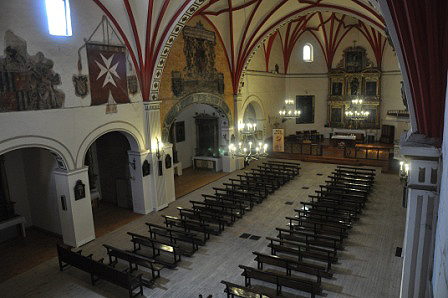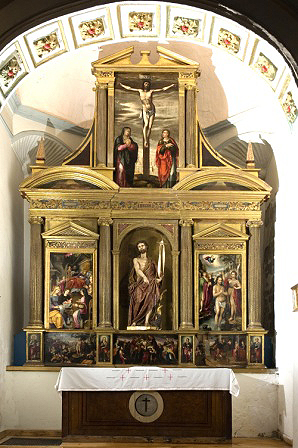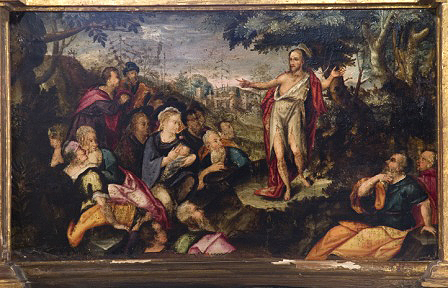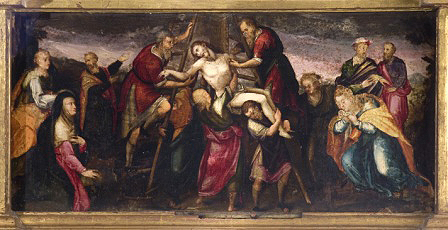The piece of the month of November 2013
JUAN DE HUICI: PROMOTER OF THE ALTARPIECE OF SAINT JOHN THE BAPTIST IN THE CHURCH OF THE CONVENT OF LOS MÍNIMOS IN CASCANTE
María Josefa Tarifa Castilla
University of Zaragoza
One of the jewels of the Renaissance architectural heritage of the Navarrese town of Cascante is the church of the primitive convent of Nuestra Señora de la Victoria, the only foundation that the friars of the Order of the Minims made in Navarre at the end of the 16th century. It is a church with a single nave divided into three bays, on the sides of which there are niche chapels of different types development, an example of the artistic promotion carried out by noble families from the town, who acquired them for funerary purposes. Until now we have known the names of the wealthy patrons who made possible the construction of some of these chapels, originally endowed with a rich artistic decoration, such as that of the Assumption, founded in 1593 by the prior of Berlanga, Luis Cervantes Enríquez de Navarra, presided over by an altarpiece whose central panel dedicated to the Assumption and Coronation of the Virgin is the work of a painter influenced by the Flemish Rolan Mois; the chapel of San Francisco de Paula founded by Miguel Cruzat, prior of the order of San Juan de Jesuralén, as indicated by the pictorial banner of the Maltese cross that hangs over the archway leading to it; or the chapel of San Miguel, whose board of trustees was held by the López de Ribaforada family, as the pictorial coat of arms by Juan de Lumbier continues to indicate, among others.

Church of the convent of Nuestra Señora de la Victoria de Cascante
Photo: M.J. Tarifa
In addition to the chapels of the Assumption, San Francisco de Paula, San Miguel, Nuestra Señora de la Soledad, on the Gospel side, and of Santo Cristo, las Ánimas, Nuestra Señora de la Concepción and Nuestra Señora del Pilar, in their original dedications, on the right side of the nave the church originally had another chapel located at the foot of the church, on the Epistle side and under the choir loft, built at the beginning of the 17th century, of which we knew nothing until now. The finding of data unpublished documents located in different Navarrese archives provide us with information regarding its original board of trustees, dedication and altarpiece with which the room was endowed.
The aforementioned chapel, instituted under the patronage of San Diego, was acquired on 22 July 1613 by graduate Juan de Huici, vicar of the parish of Cascante, with the right of burial for himself and his relatives and "to place a tombstone and coats of arms and decorate it with the insignia that he sees fit, placing in it, if he sees fit, another altarpiece of any saint or saints that he sees fit and rexa or rexado and to make tombs and burials at his own free will". In addition to the allowance given to the friars for the use and ownership of the outbuilding, 103 and a half robos of wheat, 10 ducats and a census on a plot of land, the vicar also undertook to endow this room with an altarpiece dedicated to St. John the Baptist, St. John the Evangelist and St. Joseph. Subsequently, the chapel always appears in the documentation identified under the ownership of the saint patron saint of the promoter, that is, the Precursor, so we deduce that the owner of the piece of furniture would be the same.

Altarpiece of San Juan Bautista. 1615. Attributed to Juan de Lumbier
Church of the convent of Nuestra Señora de la Victoria in Cascante.
Photo: R. Lapuente
Our research has led us to conclude that the aforementioned altarpiece is none other than the piece of furniture that is currently found in the first chapel located at the foot of the church on the gospel side, which was acquired in 1603 by the brotherhoods of Nuestra Señora de la Soledad, who commissioned its Building to the village worker Agustín Ximénez. This chapel housed the images of the brotherhood that were carried in processions on Good Friday, until 1826, when, with the acquisition of new figures, such as an articulated Christ with his cross and the image of the Virgin of Solitude by the Larragan sculptor Miguel Zufía, the space became insufficient. For this reason, part of the figures were moved to the chapel of the Cristo de la Vera Cruz, the closest to the chancel on the right-hand side, following permission from their owners, the Grasa and Guerra de la Vega families, at apply for .
After 1826 and before 1869, the altarpiece of San Juan Bautista was moved to the aforementioned chapel of Nuestra Señora de la Soledad, where it is still kept today. Perhaps the reason for the transfer of the piece of furniture is due to the architectural interventions that this space at the foot of the church underwent after the exclaustration of the Mínimos, as a consequence of Mendizábal's disentailment measures, in order to make the convent's rooms that communicated with the church independent, which became a parish church in August 1869, and in turn a series of rooms were fitted out in this area for the parish priest's living quarters.
As for the altarpiece of San Juan Bautista, it is an outstanding work of Navarrese art whose pictorial panels have been attributed to the painter Juan de Lumbier, a Navarrese artist active in Tudela between 1578-†1626, who has an extensive production in La Ribera, as well as in towns in Aragon and La Rioja. This work is dated on the piece of furniture itself, the year 1615.
The architecture of the altarpiece is in keeping with the classicist style prevailing at the beginning of the 17th century, consisting of a predella on which sits a single body articulated in three aisles separated by columns with fluted shafts and Ionic capitals, whose rectangular boxes culminate in a pediment, triangular on the sides and curved in the centre. Above the separating frieze, two curved pediments finish off the side aisles, punctuated by pinnacles at the ends. The attic culminates in an attic formed by a central body also articulated by Ionic columns that are joined to the lower one by finials, topped by a split pediment.
The scenes show different episodes from the life of the Precursor, with well-structured compositions and a vibrant chromatic palette. On the bench are the Preaching to the Gentiles, the Descent of Jesus and the Beheading of the Baptist, separated by the bases of the columns where the four evangelists are depicted. The body contains the panels of the Birth of Saint John and the Baptism of Christ in the Jordan, paintings very similar to the same scenes depicted by this artist in the parish church of San Juan Bautista de Cortes a few years earlier, in 1608, which has led scholars to confirm their attribution. All of this is crowned by the scene of Calvary.
The central street of the altarpiece is presided over by the carving of the patron saint, in the Romanesque style. Saint John, standing upright and in contraposto, wears a red tunic that covers a large part of his muscular body, leaving his right arm and half of his thorax bare. With the index finger of his right hand he points to the lamb at his feet.

Altarpiece of Saint John the Baptist. Detail of the Preaching to the Gentiles.1615
Attributed to Juan de Lumbier. Church of the convent of Nuestra Señora de la Victoria in Cascante.
Photo: R. Lapuente

Altarpiece of Saint John the Baptist. Detail of the Descent from the Cross.1615
Attributed to Juan de Lumbier. Church of the convent of Nuestra Señora de la Victoria in Cascante.
Photo: R. Lapuente
bibliography
- CRIADO MAINAR, J. and CARRETERO CALVO, R., Las tablas de Juan de Lumbier en el Museo de la Colegiata de Borja, Borja, Centro de programs of study Borjanos de la Institución Fernando el Católico, 20008, pp. 25-30.
- FERNÁNDEZ GRACIA, R. (Coord.), GARCÍA GAINZA, M.C. and ECHEVERRÍA GOÑI, P.L., El Arte del Renacimiento en Navarra, Pamplona, Gobierno de Navarra, 2005, pp. 366-367.
- FERNÁNDEZ framework, J.I., "Nuestra Señora de la Victoria. Cascante", Temas de Cultura Popular, nº 348, Pamplona, Diputación Foral de Navarra.
- FERNÁNDEZ framework, J.I., Cascante, ciudad de la Ribera, t. II, 2006.
- GARCÍA GAINZA, M.C., HEREDIA MORENO, C., RIVAS CARMONA, J. and ORBE SIVATTE, M., Catalog Monumental de Navarra, I. Merindad de Tudela, Pamplona, Institución Príncipe de Viana, 1980, pp. 49-53.
- TARIFA CASTILLA, M.J., La arquitectura religiosa del siglo XVI en la Merindad de Tudela, Pamplona, Gobierno de Navarra, 2005, pp. 340-362.
- TARIFA CASTILLA, M.J., "La imagen del poder de la nobleza navarra del siglo XVI a través de la promoción de obras de arte", in VI congress de Historia de Navarra, Navarra: report e Imagen, Pamplona, SEHN, September 19-22, 2006, pp. 507-522.
